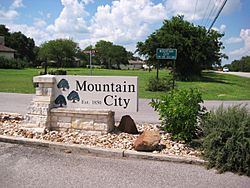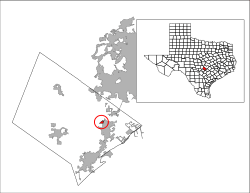Mountain City, Texas facts for kids
Quick facts for kids
Mountain City, Texas
|
|
|---|---|

Entrance to the community of Mountain City.
|
|

Location of Mountain City, Texas
|
|
 |
|
| Country | United States |
| State | Texas |
| County | Hays |
| Incorporated | 1984 |
| Area | |
| • Total | 0.53 sq mi (1.36 km2) |
| • Land | 0.53 sq mi (1.36 km2) |
| • Water | 0.00 sq mi (0.00 km2) |
| Elevation | 846 ft (258 m) |
| Population
(2020)
|
|
| • Total | 622 |
| • Density | 1,174/sq mi (457.4/km2) |
| Time zone | UTC-6 (Central (CST)) |
| • Summer (DST) | UTC-5 (CDT) |
| ZIP code |
78610
|
| Area code(s) | 512 |
| FIPS code | 48-49600 |
| GNIS feature ID | 2411184 |
Mountain City is a small city in Hays County, Texas, United States. In 2020, about 622 people lived there. It's a quiet community with a rich history.
Contents
History of Mountain City
Mountain City was once a very important place. From the 1850s to the 1880s, it was a busy center for farms and ranches. It was located on an old Stagecoach Road. The original area of Mountain City was quite large. It stretched from the Blanco River to areas near present-day Kyle and Buda.
Early Settlers Arrive
The first settlers came to Mountain City around 1835 and 1836. One of them was Phillip Allen and his family. They came from Chattanooga. Allen bought over 4,600 acres (19 km2) of land. This land was part of a grant from the Republic of Texas.
However, Native Americans lived in the area. They fought to keep their land. This made it hard for settlers to stay. Allen even left to fight for Texas independence against Mexico.
In 1846, the Texas Rangers helped make the area safer. After this, Allen and his family successfully settled their land. When Hays County was formed two years later, Allen became one of its first leaders. He was active in local government until he died in 1860.
More Families Join the Community
Another important early family was the Buntons. John Wheeler Bunton moved to Texas in the 1830s. He signed the Texas Declaration of Independence. He also served in the first Texas legislature. After the Texas Revolution, Bunton went back to Tennessee. He married his sweetheart and brought 140 settlers back to Texas.
On their way, their ship was captured by a Mexican warship. The group was held in Mexico City for three days. But John's wife, Mary Howell Bunton, was very clever. She convinced their captors that they were American citizens. She said they were legally entering Texas under a colonization law.
After being released, the Buntons continued to Mountain City. They built their home, "Rancho Rambolette." They started farming and raising a family. Other early families included the Vaughans, Bartons, and Moores.
Growth and Development
Texas's population grew quickly in the 1850s. Mountain City also grew. The small farming and ranching community began to do well. It soon had schools, churches, and businesses. There were also mills and gins for processing crops.
In 1855, the community built its first school, Live Oak Academy. Professor Gibson was the first teacher. Later, John Edgar taught there. Other nearby communities also had schools and small shops. The first church, Cumberland Presbyterian Church, was formed in 1855. Baptist and Methodist churches followed in the 1870s.
Col. W.W. Haupt arrived in 1857. He opened a store that became the Mountain City post office. He also worked as the postmaster. Two other big stores were located about a mile north. During the Civil War, the population grew even more. Many young men from Mountain City joined the army.
The Railroad's Impact
Like many small towns, Mountain City's future depended on the railroad. For isolated communities, the railroad was a huge change. It brought mail, trade, and connections to bigger cities. These included Austin and San Antonio.
There was a big competition to get a train depot. The family of State Senator Fergus Kyle lived south of Mountain City. They had strong political connections. They managed to get the train tracks laid through their area. This meant the tracks bypassed Mountain City to the east.
The Kyle family gave 200 acres (0.81 km2) of land to the International-Great Northern Railroad. This secured their place in history. A new town was founded and named after them: Kyle. From that moment, Mountain City's importance began to fade.
As the new railroad towns of Buda and Kyle grew in the 1880s, people started to leave Mountain City. The community quickly became much smaller. Local schools stayed open until the early 1930s. This was the only sign that the area had once been a major center for business.
By 1990, Mountain City's population was 377. It grew to 671 by the 2000 census. Today, it has over 700 residents.
Geography
Mountain City is located in Texas. It sits between the cities of Kyle and Buda. It is about 20 miles (32 km) southwest of Austin.
The city covers a total area of about 0.5 square miles (1.2 km2). All of this area is land.
Population Information
| Historical population | |||
|---|---|---|---|
| Census | Pop. | %± | |
| 1990 | 377 | — | |
| 2000 | 671 | 78.0% | |
| 2010 | 648 | −3.4% | |
| 2020 | 622 | −4.0% | |
| U.S. Decennial Census 2020 Census |
|||
In 2000, there were 671 people living in Mountain City. There were 215 households and 202 families. The population density was about 1,455 people per square mile.
Many households had children under 18 living with them (55.8%). Most households (86.5%) were married couples. The average household had 3.12 people. The average family had 3.23 people.
The population was spread out by age. About 31.7% of residents were under 18. About 4.8% were 65 years or older. The average age was 38 years old.
Education
The schools in Mountain City are part of the Hays Consolidated Independent School District.
See also
 In Spanish: Mountain City (Texas) para niños
In Spanish: Mountain City (Texas) para niños

